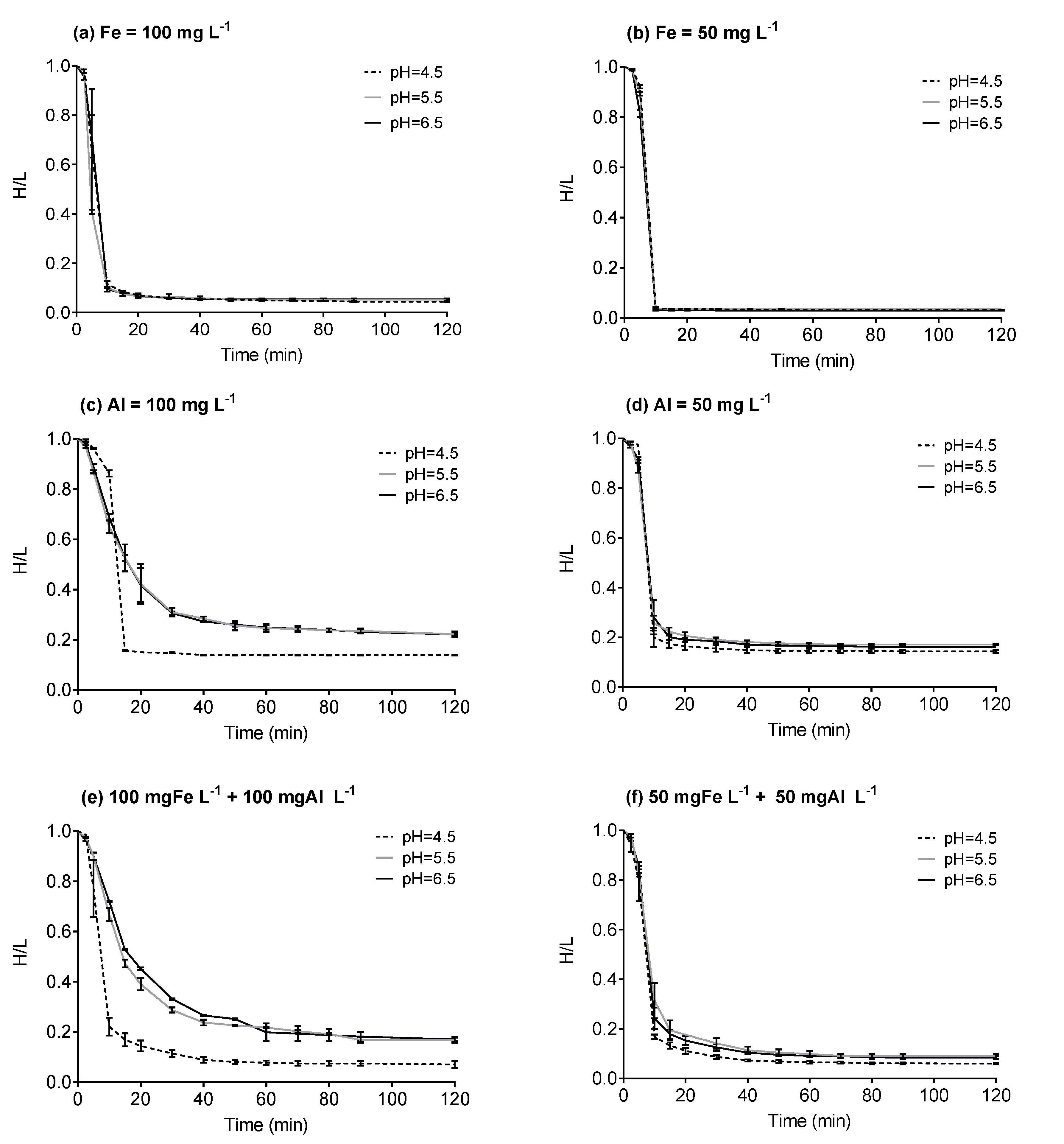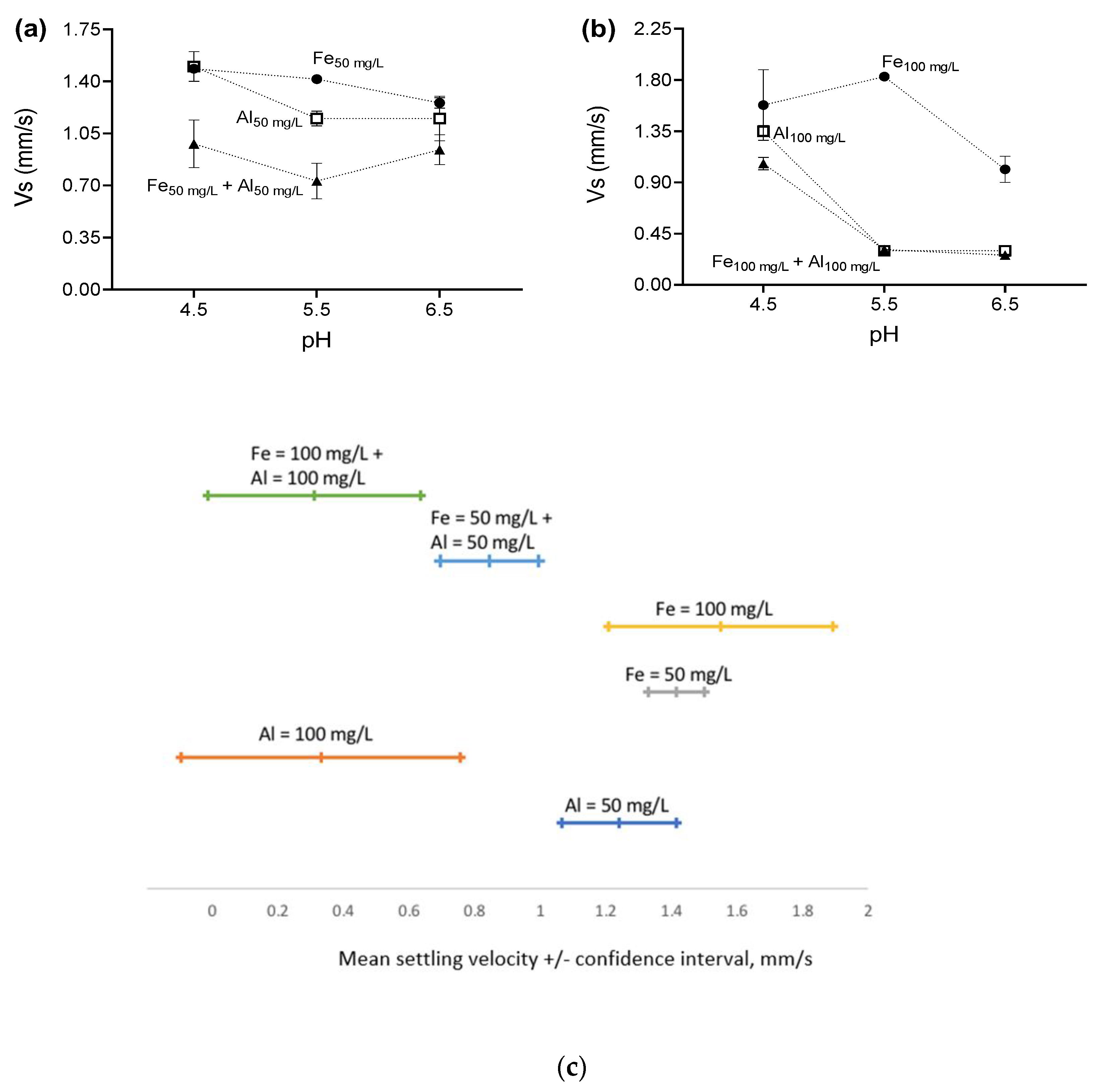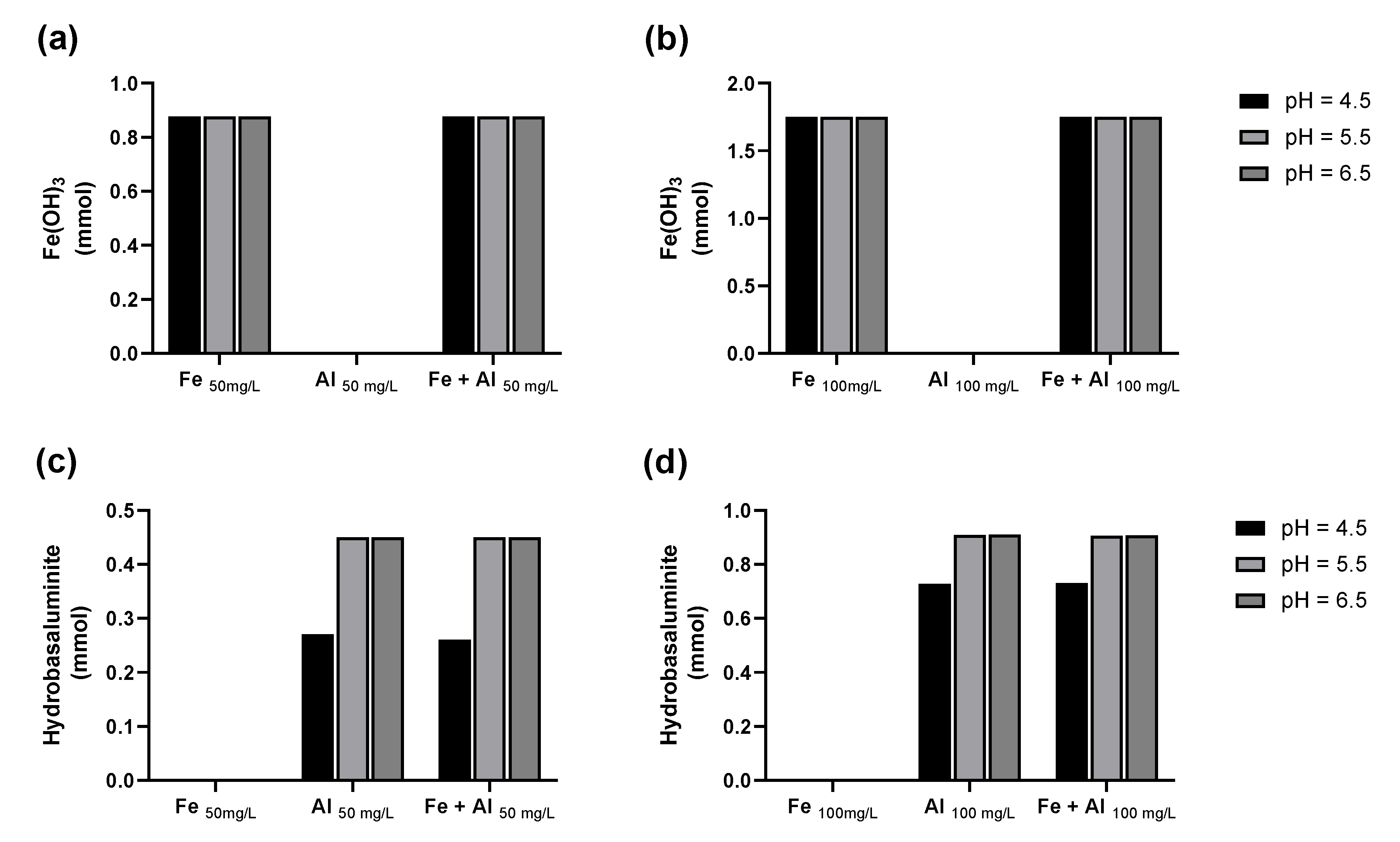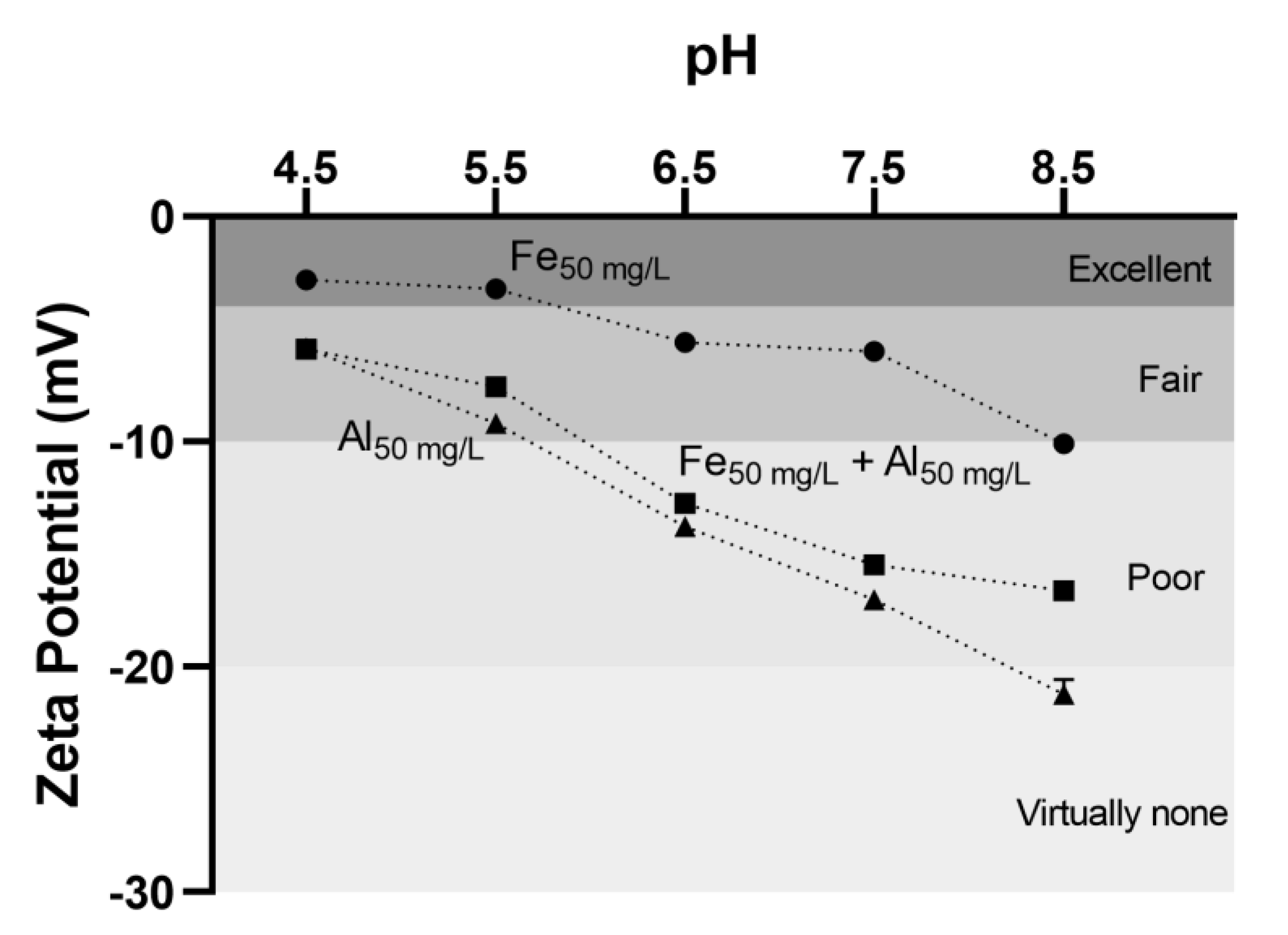Settling of Iron and Aluminum Particles in Acid Solutions for Acid Drainage Remediation
Abstract
:1. Introduction
2. Materials and Methods
2.1. Preparation of Synthetic Acid Drainage
2.2. Mixing, Coagulation, and Flocculation for the Formation of Iron and Aluminum Flocs
2.3. Settling Column Tests
2.3.1. Settling of Freshly Formed Flocs
2.3.2. Settling Velocity Determination
2.4. Geochemical Modeling
2.5. Zeta Potential Measurements
3. Results
3.1. Settling Tests
Settling Velocity
3.2. Geochemical Modeling
3.3. Zeta Potential Measurements
4. Discussion
4.1. Iron Flocs Tend to Settle Faster Than Aluminum Flocs
4.2. Mixed Suspensions Tended towards the Lowest Settling Velocities
4.3. pH Influences Iron, Aluminum, and Mixed Suspensions Settling
4.4. Colloid Instability in Synthetic Mine Drainage Solutions Is Higher under Acidic Conditions
5. Conclusions
Supplementary Materials
Author Contributions
Funding
Acknowledgments
Conflicts of Interest
References
- Oyewo, O.A.; Agboola, O.; Onyango, M.S.; Popoola, P.; Bobape, M.F. Current Methods for the Remediation of Acid Mine Drainage Including Continuous Removal of Metals From Wastewater and Mine Dump. In Bio-Geotechnologies for Mine Site Rehabilitation; Elsevier: Amsterdam, The Netherlands, 2018; pp. 103–114. ISBN 9780128129869. [Google Scholar]
- Fernando, W.A.M.; Ilankoon, I.M.S.K.; Syed, T.H.; Yellishetty, M. Challenges and Opportunities in the Removal of Sulphate Ions in Contaminated Mine Water: A Review. Miner. Eng. 2018, 117, 74–90. [Google Scholar] [CrossRef]
- Skousen, J.; Zipper, C.E.; Rose, A.; Ziemkiewicz, P.F.; Nairn, R.; McDonald, L.M.; Kleinmann, R.L. Review of Passive Systems for Acid Mine Drainage Treatment. Mine Water Environ. 2017, 36, 133–153. [Google Scholar] [CrossRef] [Green Version]
- Schwarz, A.; Nancucheo, I.; Gaete, M.A.; Muñoz, D.; Sanhueza, P.; Torregrosa, M.; Rötting, T.; Southam, G.; Aybar, M. Evaluation of Dispersed Alkaline Substrate and Diffusive Exchange System Technologies for the Passive Treatment of Copper Mining Acid Drainage. Water 2020, 12, 854. [Google Scholar] [CrossRef] [Green Version]
- Hu, Y.; Li, Q.; Lee, B.; Jun, Y.-S. Aluminum Affects Heterogeneous Fe(III) (Hydr)Oxide Nucleation, Growth, and Ostwald Ripening. Environ. Sci. Technol. 2014, 48, 299–306. [Google Scholar] [CrossRef]
- España, J.S. The Behavior of Iron and Aluminum in Acid Mine Drainage: Speciation, Mineralogy, and Environmental Significance. In Thermodynamics, Solubility and Environmental Issues; Elsevier: Amsterdam, The Netherlands, 2007; pp. 137–150. [Google Scholar]
- Sánchez-España, J.; Yusta, I.; Diez-Ercilla, M. Schwertmannite and Hydrobasaluminite: A Re-Evaluation of Their Solubility and Control on the Iron and Aluminium Concentration in Acidic Pit Lakes. Appl. Geochem. 2011, 26, 1752–1774. [Google Scholar] [CrossRef]
- Nordstrom, D.K. Hydrogeochemical Processes Governing the Origin, Transport and Fate of Major and Trace Elements from Mine Wastes and Mineralized Rock to Surface Waters. Appl. Geochem. 2011, 26, 1777–1791. [Google Scholar] [CrossRef]
- Cánovas, C.R.; Peiffer, S.; Macías, F.; Olías, M.; Nieto, J.M. Geochemical Processes in a Highly Acidic Pit Lake of the Iberian Pyrite Belt (SW Spain). Chem. Geol. 2015, 395, 144–153. [Google Scholar] [CrossRef]
- Carrero, S.; Pérez-López, R.; Fernandez-Martinez, A.; Cruz-Hernández, P.; Ayora, C.; Poulain, A. The Potential Role of Aluminium Hydroxysulphates in the Removal of Contaminants in Acid Mine Drainage. Chem. Geol. 2015, 417, 414–423. [Google Scholar] [CrossRef]
- Lecomte, K.L.; Maza, S.N.; Collo, G.; Sarmiento, A.M.; Depetris, P.J. Geochemical Behavior of an Acid Drainage System: The Case of the Amarillo River, Famatina (La Rioja, Argentina). Environ. Sci. Pollut. Res. 2017, 24, 1630–1647. [Google Scholar] [CrossRef]
- Runkel, R.L.; Bencala, K.E.; Kimball, B.A.; Walton-Day, K.; Verplanck, P.L. A Comparison of Pre- and Post-Remediation Water Quality, Mineral Creek, Colorado. Hydrol. Processes 2009, 23, 3319–3333. [Google Scholar] [CrossRef]
- Sánchez-España, J.; Yusta, I.; Burgos, W.D. Geochemistry of Dissolved Aluminum at Low PH: Hydrobasaluminite Formation and Interaction with Trace Metals, Silica and Microbial Cells under Anoxic Conditions. Chem. Geol. 2016, 441, 124–137. [Google Scholar] [CrossRef]
- Montecinos, M.; Coquery, M.; Alsina, M.A.; Bretier, M.; Gaillard, J.-F.; Dabrin, A.; Pastén, P. Partitioning of Copper at the Confluences of Andean Rivers. Chemosphere 2020, 259, 127318. [Google Scholar] [CrossRef] [PubMed]
- Contreras, M.T.; Müllendorff, D.; Pastén, P.; Pizarro, G.E.; Paola, C.; Escauriaza, C. Potential Accumulation of Contaminated Sediments in a Reservoir of a High-Andean Watershed: Morphodynamic Connections with Geochemical Processes. Water Resour. Res. 2015, 51, 3181–3192. [Google Scholar] [CrossRef]
- Menshikova, E.; Osovetsky, B.; Blinov, S.; Belkin, P. Mineral Formation under the Influence of Mine Waters (The Kizel Coal Basin, Russia). Minerals 2020, 10, 364. [Google Scholar] [CrossRef] [Green Version]
- Carroll, K.C.; López, D.L.; Stoertz, M.W. Solute Transport at Low Flow in an Acid Stream in Appalachian Ohio. Water Air Soil Pollut. 2003, 144, 195–222. [Google Scholar] [CrossRef]
- Consani, S.; Carbone, C.; Dinelli, E.; Balić-Žunić, T.; Cutroneo, L.; Capello, M.; Salviulo, G.; Lucchetti, G. Metal Transport and Remobilisation in a Basin Affected by Acid Mine Drainage: The Role of Ochreous Amorphous Precipitates. Environ. Sci. Pollut. Res. 2017, 24, 15735–15747. [Google Scholar] [CrossRef]
- Guerra, P.; Gonzalez, C.; Escauriaza, C.; Pizarro, G.; Pasten, P. Incomplete Mixing in the Fate and Transport of Arsenic at a River Affected by Acid Drainage. Water Air Soil Pollut. 2016, 227, 1–20. [Google Scholar] [CrossRef]
- Kirat, G.; Aydin, N. Investigation of Metal Pollution in Moryayla (Erzurum) and Surrounding Stream Sediments, Turkey. Int. J. Environ. Sci. Technol. 2018, 15, 2229–2240. [Google Scholar] [CrossRef]
- Ruiz, F.; González-Regalado, M.L.; Muñoz, J.M.; Abad, M.; Toscano, A.; Prudencio, M.I.; Dias, M.I. Distribution of Heavy Metals and Pollution Pathways in a Shallow Marine Shelf: Assessment for a Future Management. Int. J. Environ. Sci. Technol. 2014, 11, 1249–1258. [Google Scholar] [CrossRef] [Green Version]
- Schemel, L.E.; Kimball, B.A.; Bencala, K.E. Colloid Formation and Metal Transport through Two Mixing Zones Affected by Acid Mine Drainage near Silverton, Colorado. Appl. Geochem. 2000, 15, 1003–1018. [Google Scholar] [CrossRef]
- Allman, C.J.; Gómez-Ortiz, D.; Burke, A.; Amils, R.; Rodriguez, N.; Fernández-Remolar, D. Hydrogeochemical Variability of the Acidic Springs in the Rio Tinto Headwaters. Water 2021, 13, 2861. [Google Scholar] [CrossRef]
- Biati, A.; Karbassi, A.R. Comparison of Controlling Mechanisms of Flocculation Processes in Estuaries. Int. J. Environ. Sci. Technol. 2010, 7, 731–736. [Google Scholar] [CrossRef] [Green Version]
- Abarca, M.; Guerra, P.; Arce, G.; Montecinos, M.; Escauriaza, C.; Coquery, M.; Pastén, P. Response of Suspended Sediment Particle Size Distributions to Changes in Water Chemistry at an Andean Mountain Stream Confluence Receiving Arsenic Rich Acid Drainage. Hydrol. Processes 2017, 31, 296–307. [Google Scholar] [CrossRef]
- Arce, G.; Montecinos, M.; Guerra, P.; Escauriaza, C.; Coquery, M.; Pastén, P. Enhancement of Particle Aggregation in the Presence of Organic Matter during Neutralization of Acid Drainage in a Stream Confluence and Its Effect on Arsenic Immobilization. Chemosphere 2017, 180, 574–583. [Google Scholar] [CrossRef] [PubMed]
- Schwarz, C.; Cox, T.; van Engeland, T.; van Oevelen, D.; van Belzen, J.; van de Koppel, J.; Soetaert, K.; Bouma, T.J.; Meire, P.; Temmerman, S. Field Estimates of Floc Dynamics and Settling Velocities in a Tidal Creek with Significant Along-Channel Gradients in Velocity and SPM. Estuar. Coast. Shelf Sci. 2017, 197, 221–235. [Google Scholar] [CrossRef]
- Droppo, I.G. Rethinking What Constitutes Suspended Sediment. Hydrol. Processes 2001, 15, 1551–1564. [Google Scholar] [CrossRef]
- Shankar, M.S.; Pandey, M.; Shukla, A.K. Analysis of Existing Equations for Calculating the Settling Velocity. Water 2021, 13, 1987. [Google Scholar] [CrossRef]
- Bigham, J.; Fitzpatrick, R.W.; Schulze, D. Iron Oxides. Soil Mineral. Environ. Appl. 2002, 7, 323–366. [Google Scholar]
- Bigham, J.; Nordstrom, D.K. Iron and Aluminum Hydroxysulfates from Acid Sulfate Waters. Rev. Mineral. Geochem. 2000, 40, 351–403. [Google Scholar] [CrossRef]
- Hogg, R. Flocculation and Dewatering. Int. J. Miner. Processing 2000, 58, 223–236. [Google Scholar] [CrossRef]
- Adra, A.; Morin, G.; Ona-Nguema, G.; Menguy, N.; Maillot, F.; Casiot, C.; Bruneel, O.; Lebrun, S.; Juillot, F.; Brest, J. Arsenic Scavenging by Aluminum-Substituted Ferrihydrites in a Circumneutral PH River Impacted by Acid Mine Drainage. Environ. Sci. Technol. 2013, 47, 12784–12792. [Google Scholar] [CrossRef] [PubMed]
- Burgos, W.D.; Borch, T.; Troyer, L.D.; Luan, F.; Larson, L.N.; Brown, J.F.; Lambson, J.; Shimizu, M. Schwertmannite and Fe Oxides Formed by Biological Low-PH Fe (II) Oxidation versus Abiotic Neutralization: Impact on Trace Metal Sequestration. Geochim. Cosmochim. Acta 2012, 76, 29–44. [Google Scholar] [CrossRef]
- Ye, C.; Ariya, P.A.; Fu, F.; Yu, G.; Tang, B. Influence of Al(III) and Sb(V) on the Transformation of Ferrihydrite Nanoparticles: Interaction among Ferrihydrite, Coprecipitated Al(III) and Sb(V). J. Hazard. Mater. 2020, 408, 124423. [Google Scholar] [CrossRef]
- Yukselen, M.A.; Gregory, J. The Effect of Rapid Mixing on the Break-up and Re-Formation of Flocs. J. Chem. Technol. Biotechnol. 2004, 79, 782–788. [Google Scholar] [CrossRef]
- Concha, A.; Kynch, K. Theory of Sedimentation. In Solid-Liquid Separation in the Mining Industry; Concha, A.F., Ed.; Springer: Berlin/Heidelberg, Germany, 2014; pp. 97–118. ISBN 978-3-319-02484-4. [Google Scholar]
- Major, J.J. Hindered Settling BT-Encyclopedia of Sediments and Sedimentary Rocks; Middleton, G.V., Church, M.J., Coniglio, M., Hardie, L.A., Longstaffe, F.J., Eds.; Springer: Dordrecht, The Netherlands, 2003; pp. 358–360. ISBN 978-1-4020-3609-5. [Google Scholar]
- Derksen, J.J. Simulations of Hindered Settling of Flocculating Spherical Particles. Int. J. Multiph. Flow 2014, 58, 127–138. [Google Scholar] [CrossRef]
- Vanoni Vito, A. Sedimentation Engineering; American Society of Civil Engineering: Reston, VA, USA, 2006; ISBN 978-0-7844-0823-0. [Google Scholar]
- Bhargava, D.; Rajagopal, K. Differentiation between Transition Zone and Compression in Zone Settling. Water Res. 1993, 27, 457–463. [Google Scholar] [CrossRef]
- Bian, J.; Wang, H.; Xiao, C.; Zhang, D. An Experimental Study on the Flocculating Settling of Unclassified Tailings. PLoS ONE 2018, 13, e0204230. [Google Scholar] [CrossRef] [PubMed]
- Fritsch, F.N.; Carlson, R.E. Monotone Piecewise Cubic Interpolation. SIAM J. Numer. Anal. 1980, 17, 238–246. [Google Scholar] [CrossRef]
- Ball, J.; Nordstrom, D.K. User’s Manual for WATEQ4F, with Revised Thermodynamic Data Base and Text Cases for Calculating Speciation of Major, Trace, and Redox Elements in Natural Waters; US Geological Survey: Reston, VA, USA, 1991. [Google Scholar]
- Kirk Nordstrom, D. Geochemical Modeling of Iron and Aluminum Precipitation during Mixing and Neutralization of Acid Mine Drainage. Minerals 2020, 10, 547. [Google Scholar] [CrossRef]
- Caraballo, M.A.; Wanty, R.B.; Verplanck, P.L.; Navarro-Valdivia, L.; Ayora, C.; Hochella, M.F., Jr. Aluminum Mobility in Mildly Acidic Mine Drainage: Interactions between Hydrobasaluminite, Silica and Trace Metals from the Nano to the Meso-Scale. Chem. Geol. 2019, 519, 1–10. [Google Scholar] [CrossRef]
- Grundl, T.; Delwiche, J. Kinetics of Ferric Oxyhydroxide Precipitation. J. Contam. Hydrol. 1993, 14, 71–87. [Google Scholar] [CrossRef]
- Shammas, N. Coagulation and Flocculation. In Physicochemical Treatment Processes. Handbook of Environmental Engineering; Wang, L.K., Hung, Y.-T., Shammas, N.K., Eds.; Humana Press: Totowa, NJ, USA, 2005; Volume 3. [Google Scholar]
- Mineralogy Database. Schwertmannite Mineral Data; 2009. Available online: http://webmin.mindat.org/data/Schwertmannite.shtml#.Ys9zNTdBxPZ (accessed on 31 May 2022).
- Mineralogy Database. Jarosite Mineral Data; 2009. Available online: http://webmineral.com/data/Jarosite.shtml#.Ys9zkjdBxPY (accessed on 31 May 2022).
- Mineralogy Database. Hydrobasaluminite Mineral Data; 2009. Available online: http://www.webmineral.com/data/Hydrobasaluminite.shtml#.Ys9zxTdBxPY (accessed on 31 May 2022).
- Balistrieri, L.; Seal, R.R.; Piatak, N.M.; Paul, B. Assessing the Concentration, Speciation, and Toxicity of Dissolved Metals during Mixing of Acid-Mine Drainage and Ambient River Water Downstream of the Elizabeth Copper Mine, Vermont, USA. Appl. Geochem. 2007, 22, 930–952. [Google Scholar] [CrossRef]
- Civeira, M.; Oliveira, M.L.S.; Hower, J.C.; Agudelo-Castañeda, D.M.; Taffarel, S.R.; Ramos, C.G.; Kautzmann, R.M.; Silva, L.F.O. Modification, Adsorption, and Geochemistry Processes on Altered Minerals and Amorphous Phases on the Nanometer Scale: Examples from Copper Mining Refuse, Touro, Spain. Environ. Sci. Pollut. Res. 2016, 23, 6535–6545. [Google Scholar] [CrossRef] [PubMed]
- Cruz-Hernández, P.; Peréz-López, R.; Nieto, J.M. Role of Arsenic During the Aging of Acid Mine Drainage Precipitates. Procedia Earth Planet. Sci. 2017, 17, 233–236. [Google Scholar] [CrossRef] [Green Version]
- Olias, M.; Nieto, J.M.; Sarmiento, A.M.; Ceron, J.C.; Canovas, C.R. Seasonal Water Quality Variations in a River Affected by Acid Mine Drainage: The Odiel River (South West Spain). Sci. Total Environ. 2004, 333, 267–281. [Google Scholar] [CrossRef]
- Romero, L.; Alonso, H.; Campano, P.; Fanfani, L.; Cidu, R.; Dadea, C.; Keegan, T.; Thornton, I.; Farago, M. Arsenic Enrichment in Waters and Sediments of the Rio Loa (Second Region, Chile). Appl. Geochem. 2003, 18, 1399–1416. [Google Scholar] [CrossRef]
- Dempsey, B.A.; Jeon, B.-H. Characteristics of Sludge Produced from Passive Treatment of Mine Drainage. Geochem. Explor. Environ. Anal. 2001, 1, 89. [Google Scholar] [CrossRef]




| Solution | Fe3+ (mg/L) | Al3+ (mg/L) | SO42− (g/L) | Ionic Strength (M) |
|---|---|---|---|---|
| 100 mg Fe/L | 100 | 0 | 2.4 | 0.13 |
| 100 mg Al/L | 0 | 100 | 2.4 | 0.13 |
| 100 mg Fe/L + 100 mg Al/L | 100 | 100 | 2.4 | 0.26 |
| 50 mg Fe/L | 50 | 0 | 2.4 | 0.11 |
| 50 mg Al/L | 0 | 50 | 2.4 | 0.11 |
| 50 mg Fe/L + 50 mg Al/L | 50 | 50 | 2.4 | 0.22 |
Publisher’s Note: MDPI stays neutral with regard to jurisdictional claims in published maps and institutional affiliations. |
© 2022 by the authors. Licensee MDPI, Basel, Switzerland. This article is an open access article distributed under the terms and conditions of the Creative Commons Attribution (CC BY) license (https://creativecommons.org/licenses/by/4.0/).
Share and Cite
Guerra, P.; Valenzuela, J.; Rámila, C.; Cattaneo, G. Settling of Iron and Aluminum Particles in Acid Solutions for Acid Drainage Remediation. Water 2022, 14, 2231. https://doi.org/10.3390/w14142231
Guerra P, Valenzuela J, Rámila C, Cattaneo G. Settling of Iron and Aluminum Particles in Acid Solutions for Acid Drainage Remediation. Water. 2022; 14(14):2231. https://doi.org/10.3390/w14142231
Chicago/Turabian StyleGuerra, Paula, Julio Valenzuela, Consuelo Rámila, and Giannina Cattaneo. 2022. "Settling of Iron and Aluminum Particles in Acid Solutions for Acid Drainage Remediation" Water 14, no. 14: 2231. https://doi.org/10.3390/w14142231
APA StyleGuerra, P., Valenzuela, J., Rámila, C., & Cattaneo, G. (2022). Settling of Iron and Aluminum Particles in Acid Solutions for Acid Drainage Remediation. Water, 14(14), 2231. https://doi.org/10.3390/w14142231






